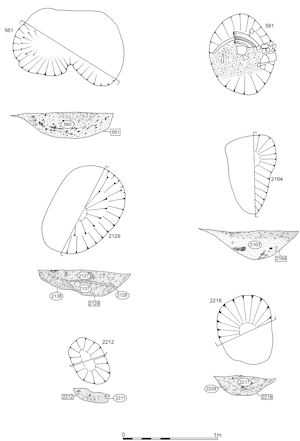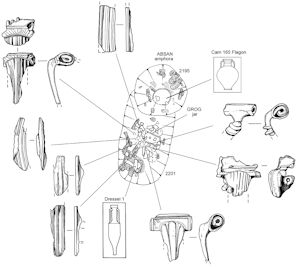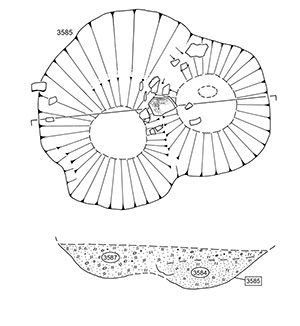
A number of pits are located within OA40 (Figure 52). Most of these appear to occupy the south-west corner of the field and be in close association with the complex of pyre site features in this same vicinity. A small quantity of further unassociated pits is also present.
Many of the generally circular or oval pits that occupy the southern part of OA40 constitute pyre-related features. While morphologically dissimilar to the pyre sites themselves, these pits contain similar charcoal-rich fills and a range of burnt artefacts that are strongly reminiscent of the pyre site assemblages. Discussion of their significance in relation to the pyre sites and Period 2B funerary practice generally is presented in Volume 1 (Atkinson and Preston 2015, Chapter 7). Pits 537 and 581 in fact lie just to the south, in OA38, but are considered here due to their marked association with the OA40 pits, being evident outliers of this group.
Oval cut, 0.57m by 0.5m and 0.13m deep. Three fills, the middle one being charcoal-rich and containing burnt human bone (160g). A few grog-tempered bodysherds and five iron nails also present. Soil samples 37, 38 and 41.
Oval cut, 0.8m by 0.35m and 0.07m deep. Single fill containing charcoal concentration toward centre. Soil sample 43.
Oval cut, 0.76m by 0.5m and 0.2m deep. Single charcoal-rich fill. Contains burnt human bone (12g), a grog-tempered bodysherd and residual prehistoric pottery. Soil sample 55.
Irregular oval cut (possibly two features?), 1.25m by 1.2m and 0.28m deep (Figure 62). Markedly deeper at one end than the other. Single charcoal-rich fill containing burnt pebbles, a charred timber fragment, burnt bone (1g), burnt grog-tempered pottery and a daub fragment.

Oval 'cut', 0.5m by 0.3m and 0.12m deep (Figure 62). Two charcoal-rich fills. Part of a burnt Cam 210 tazza-bowl contained burnt human bone (8g). However, this may be coincidental, as it seems unlikely that the tazza-bowl is deposited to hold the cremated material - the vessel having been burnt on the pyre. Deposits 516 and 562, originally recorded as fills of ditch 605, are probably related to this cremation deposit. 562 contains charcoal, burnt pebbles and a tiny amount of burnt bone (<1g); 516 contains 2g of burnt bone. Soil samples 59 and 84.
Oval cut 0.75m by 0.66m and 0.35m deep. Single charcoal-rich fill containing burnt pebbles, slag, briquetage, ?tile and Roman pottery.
Oval cut, 1.0m by 0.7m and 0.27m deep (Figure 62). Four charcoal-rich fills including burnt pebbles. Possible signs of in situ burning. Contains a small amount of burnt bone (18g). Burnt sherds of a grog-tempered jar in top fill. Soil sample 85.
Shallow oval cut, 1.18m by 0.9m and 0.14m deep. Two charcoal-rich fills, containing burnt pebbles, slag, burnt bone, one Fe nail, heavily burnt grog-tempered and Romanising pottery.

Circular cut, 0.65m diameter and 0.24m deep (Figure 61). Cut into north end of pyre site 2201. Five fills, some charcoal- and ash-rich, including burnt pebbles and human bone (307g) - some perhaps deriving from 2201. Large burnt wood fragments lined upper part of cut. Some of the cremated bone apparently within an unburnt Cam 165 flagon, truncated by ploughing (Figure 64). A burnt Dr 1 or 2-4 amphora bodysherd also present. Also contains an iron nail (SF2310), a flint flake and baked clay. Soil samples 106, ?113, 290.

Small charcoal-rich deposit, 0.17m by 0.14m and 0.09m deep. No cut discerned/recorded. No finds. Soil sample 115.
Oval cut, 0.55 x 0.38m and 0.16m deep (Figure 62). Single charcoal-rich fill including burnt stones. Tiny amount of burnt bone (<1g), but no other artefacts. Soil sample 103.
Circular cut, 0.65m diameter and 0.53m deep (Figure 62). Two fills, the upper charcoal-rich and containing burnt base sherds of a single grog-tempered jar, probably broken as a result of pyre damage.
Oval cut, 0.31m by 0.18m and 0.04m deep. Single fill containing charcoal fragments. No finds. Soil sample 159.
Circular cut, 0.6m diameter and 0.11m deep. Two charcoal-rich fills including burnt pebbles. Also contains tiny amount of burnt bone (2g) and slag (408g). Soil samples 178 and 179.

Irregular-shaped cut, 0.93m by 0.76m and 0.16m deep (Figure 68). Cut comprises two 'scoops' with a single fill. Contains only a tiny amount of burnt bone (<1g), burnt sherds of up to six small beakers, some with burnt bone adhering, a copper-alloy brooch fragment (SF169), an iron nail, glass sherd and charcoal. Soil samples 202 and 203.
Pits 481, 544, 547, 592, 594, 602, 610 are all located in the south-eastern part of OA40 (Group 324), close to boundary ditch 25188. Containing charcoal-free gravelly silt fills, they are clearly different from those identified as pyre-related pits. Pits 544, 547 and 602 form an inter-cutting line.
Pit 2905 is located on its own at some distance north of all the other Period 2B pits and pyre-sites that occupy OA40.
Internet Archaeology is an open access journal based in the Department of Archaeology, University of York. Except where otherwise noted, content from this work may be used under the terms of the Creative Commons Attribution 3.0 (CC BY) Unported licence, which permits unrestricted use, distribution, and reproduction in any medium, provided that attribution to the author(s), the title of the work, the Internet Archaeology journal and the relevant URL/DOI are given.
Terms and Conditions | Legal Statements | Privacy Policy | Cookies Policy | Citing Internet Archaeology
Internet Archaeology content is preserved for the long term with the Archaeology Data Service. Help sustain and support open access publication by donating to our Open Access Archaeology Fund.